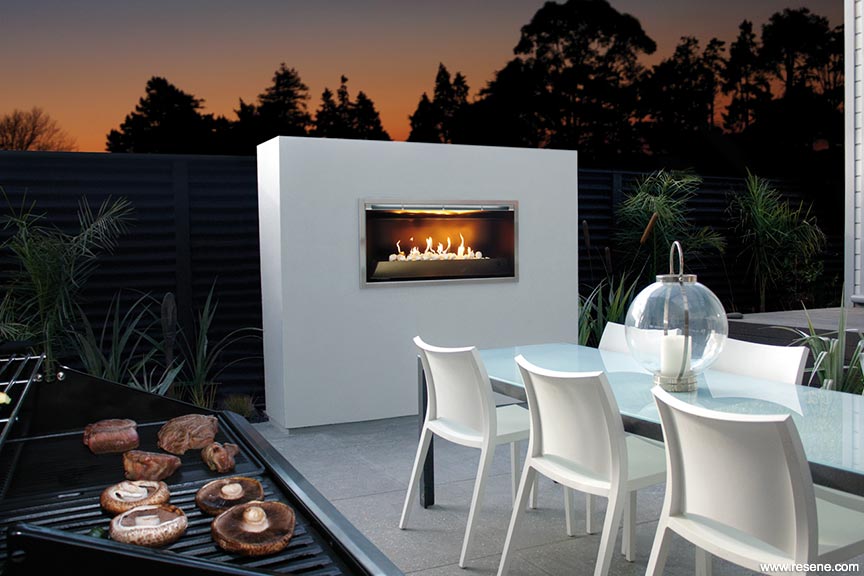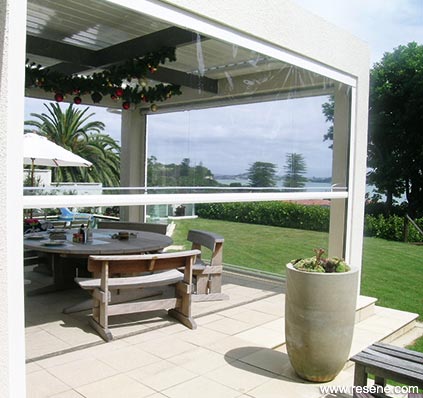From Habitat magazine - issue 17
Extending the life of our outdoor areas has become a modern lifestyle imperative.
Contemporary living calls for outdoor spaces to be an integral part of our busy lives, where we can relax and entertain our families and friends… and do it year round no matter how low the temperatures drop. Sure, we may not try sitting around the outdoor table munching on barbecued sausages in mid July, but we certainly expect to enjoy our outdoor areas well into autumn and early in spring.

To help us do that, there is an increasing array of outdoor heating, cooking, and design products available to help warm and shelter us. The sorts of items that used to only be seen in sidewalk cafes, such as roll-down PVC screens and large patio heaters, are now much more common at home. Of course, all of these elements need an holistic approach to make them look good. Which is where good landscape design comes into play.
Some of the outdoor heating options include gas, electric powered models as well as eco-friendly options that burn bioethanol, and wall-mounted infratech models. Heaters come in many forms from traditional outdoor fireplaces to wall-mounted heaters, braziers, freestanding, table-top and fire pits.

Fireplaces can range from lightweight concrete, which allows contemporary styling and is easily installed, to more conventional blockwork fireplaces built on site with additional extras, such as wood storage areas, cooking and bench space, or even a pizza oven.
The use of screens can add important shelter from the prevailing wind and extend the amount of time able to be spent outside. Screen types include solid structures such as plastered walls or lightweight concrete plastered walls, through to timber screens which allow some air and light into the area, or those that are semi-permanent like PVC sheets that can be rolled up or put away.


As landscape designer Nicky Samuel of Elan Design, Te Awamutu, says: "Popular nowadays is glass balustrading, which was previously only used on decks and around pools. But now combinations of solid walling with glass panels give the added benefit of retaining views."
Overhead structures such as pergolas are becoming increasingly sophisticated with electronically controlled louvred systems that close at the hint of rain, or that can be adjusted according to the sun's direction.
Other options include shade sails with different UV ratings in a wide range of colours and levels of permeability. Non waterproof sails are reasonably priced but waterproof fabric is heavier and will require stronger anchorage systems, so is more expensive. Good anchorage and tension is important if you don't want to be kept awake at night with canvas flapping and cracking in the wind.


Outdoor kitchens have become a hugely popular part of outdoor living, reducing the dependence on the main house kitchen and adding cooking flexibility and ambience. State of the art outdoor kitchens often include a high-end barbecue with possibly a pizza oven, work benches, a sink and storage space.
While most outdoor kitchens are made from stainless steel in modular form, purpose-built kitchens in plastered blockwork or timber may better suit individual taste. Timber may also be used for benches and work surfaces but needs to be finished with a product like Resene Woodsman Wood Oil Stain or Resene Furniture and Decking Oil. See step-by-step instructions on a smart outdoor kitchen to make.
Auckland landscape designer, Jennifer Insley of Gardens to Go, says the increasingly common trend of including outdoor areas in the original overall design of a home rather than as an added afterthought, ensures the best flow and thoughtful positioning, maximising year-round use.
Jennifer says outdoor heating is much more effective when combined with an overhead canopy for shelter. "This may be clear, flat acrylic sheeting over a pergola structure, a stretched PVC canopy, a louvred roof system or an extension of the house roof," she says.
words: Kathy Goodwin
Search habitat magazine stories
Printed copies of habitat highlights are available from late March 2024 at Resene ColorShops and resellers, while stocks last. You can view back issues of habitat magazine online.
Specifiers:
If you have an idea, project or story that you think would suit habitat, we’d love to hear from you. Please drop us an email with your details and include photos if submitting a project.
Sign up for a DIY card and Save! Australia | New Zealand